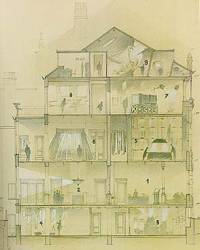- English
- Français
- Nederlands
Table of Contents
Travel Notes on the First Obscure Convention
by Sylvain St-Pierre
Wednesday, July 28th, 1999
I have not yet succeeded in compiling a table that would give a satisfactory equivalence of the Obscure time, so I will continue to use familiar dates. MM. Schuiten and Peeters have already noticed that days seem neither longer nor shorter on the Continent than in our world, but the excitation generated by this journey is seriously skewing my objectivity in this regard …
Indeed, have I already «passed»? It is hard to say for sure. I arrived in the middle of the afternoon, coming straight from London through the Chunnel. The train might have taken a side track in the darkness without me being the wiser.
Various public notices proclaim that I am in Brussels, in Belgium, but the very atmosphere seems to be permeated by the feeling of Brüsel. Obviously, it leaks! It is difficult to express in words. At any rate, the reports describing the climate of both cities as cold and rainy are apparently much exagerated. The weather is absolutly radious! Maybe professor Pym, upon learning about our expedition, has tweaked a bit the gears of Armilia? Whatever the reason, I certainly will not complain.
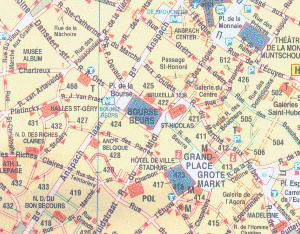
My hotel is marvellously located, barely twenty meters from the Grand’ Place. The view from my window opens on the roofs, and is very Brüselian. I can see several centuries of architectural history summarized at once. I have started to explore the neighbourhood a bit. Lots of pleasant narrow streets, crisscrossing each other according to strange angles. A pleasant change from the rectangular grid of Montreal, to wich I am more accustomed.

My first Obscure site is only a few steps away: the mural of the street Marché-au-Charbon. It's a complete surprise; I was expecting just a painted wall, but the technique used appears to be that of the sgraffite, the same as for the Maison Cauchie, which I also want to visit. I hope that my picture will turn out allright, for I heard that some of the Obscure World influences are not compatible with photography. I dined with one of my belgian contacts: Michel Kempeneers, of Leuven. It is strange indeed to meet face to face for the first time a person with whom one had only had electronic exchanges for so many months. He turns out to be a very nice guy. He also brought with him a most detailled analysis of the Obscure Dictionary, and found numerous errors that had escaped me. I will be busy editing for quite some times when I return. We discussed until late in the evening, comfortable that we were on the restaurant's terrace. The meal was excellent: rabbit à la Gueuze, a local specialty, with a most pleasant belgian beer.
Michel also left me several documents of a great interest, including an article on Schuiten and Peeters that he wrote himself for a belgian newspaper. It is too bad that I cannot read dutch. It is also regrettable that he will not be able to join the rest of us for the rest of the convention, as he his otherwise taken. It is starting so well! The full Moon is amazingly bright tonight, which I take to be a good omen. Isn't Luna a recognized point of Passage to the Obscure World?
Thursday, July 29th, 1999
It looks like another nice day ahead. It might even be rather warm! I contacted Quentin Gausset on the phone. He is a brusselite living between Copenhagen and København, but he is temporarely back in his home town. Originaly, only the both of us were supposed to meet here, but one thing led to another… The first meeting of the group is confirmed for tonight.
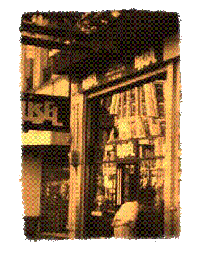
I did not have any difficulties finding something to do in the meantime: this city is full of libraries specializing in bande dessinée. What a choice! It is like a dream. The Brüsel boutique is nearby, and I waste no time getting there. Ah, such marvels! I would take everything in sight, but I settle for a few albums and a copy of the famous video Le Dossier B. I will need to have it converted to the north-american format when I come back, but this is a minor detail.
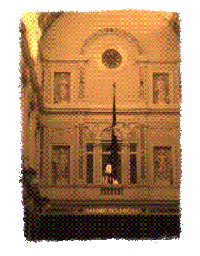
I also wandered a bit, letting chance guide my steps, and discovered many splendid things. I even visited the Galerie de la Reine. The flags that hang in the Obscure version seem totaly absent on this side, but I found a superb set of postcards about the Maison du Peuple, a building by Victor Horta. The shape of the girders of this now-vanished building is reminiscent of the pictures of Alta-Plana in L’Echo des Cités, I shall check this detail when I come back home. As soon as one get away from the center of the town, the quaint old streets disappear and are replaced by majestic avenues. It is indeed like going from world to another, and I cannot help but to look up, expecting strange airships flying overhead.

I have seen in the distance the formidable silhouette of the Palais de Justice, half hidden under strange scalfoldings. I think that I am starting to get the feel of the soul of the city. Everywhere nothing but construction, demolition and repairs! In some neighbourhoods, the noise of the jackhammers is relentless and the stinging dust clouds are impossible to escape. On the Obscure side, life must have often been unbearable for the poor inhabitants of Brüsel. I have also seen my first examples of facadism, but they are probably not the last. Our group has finally come together. First Quentin, then the Dutch contingent; Eilko Bronsema, Bert Zuur and Caspar De Wind, all arrived to my hotel, where we had set the meeting. We walked to the Ultieme Hallucinatie restaurant, which has a superb Art Nouveau décor and a name most appropriate for people like us…
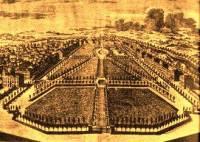
On the way, we also went by the Royal Park. Quentin explains that its paths trace many cabalistic designs and that a perfect copy used to be found in Urbicande, which is not surprising at all. The superb weather is still with us and we eat outside, in the courtyard, while planning tomorrow's schedule, which will likely be heavy. Most of the conversation is in English, for this is the only language that all five of us hold in common.
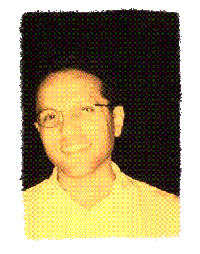
Later that evening, we met Alok Nandi, the webmaster of d'urbicande.be, and his companion, Sophie, on the terrace of the Falstaff. It is said that it is one of the most fashionable spots in the center of Brussels, and it is indeed most lively. Supposedly there are very nice glazed windows to be be seen, but always too many people in front to appreciate them fully.
Alok has proven to be a precious source of information. We drink his words, amazed by the long list of projects François and Benoît are involved in. No doubt we will be able to quench our thirst for many years to come. I think that I even understood that a visit of the authors to Montreal is not out of the question, but maybe my subconscient mind has come up with some wishful delusion.
A surprise from Alok: we were all given a copy of L’Ombre du Réseau, the CD-ROM version of the urbicande.be Web site. Apparently, these are the only ones left! Most of the members of our group thought that they would never see this rare item. The four thousand «official» copies were quickly exhausted after only a few days, and not the shadow of one was ever seen in Quebec.
I went to bed tired, but happy.
Friday, July 30th, 1999
A new visitor has joined our group: Mitya Suchin, a russian living in Berlin and with whom we all have been in contact those last few months. He is very enthousiastic about this visit, and sorry that he was not able to come in yesterday. Our convention is really becoming international!
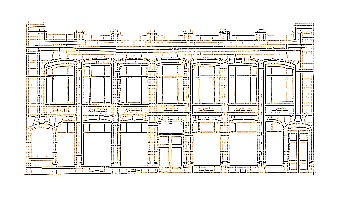
There was a slight misunderstanding about the meeting place, but Quentin eventually meet us at the Centre Belge de la Bande Dessinée. The building has been admirably well renovated, and its comic strips collections are superb. There is a gallery that shows the CBBD as rendered by different artists, which is very interesting because one can compare with the original on the spot.
The center's shop even has a copy of Paris au Vingtième Siècle, by Jules Verne, illustrated by François Schuiten. Will I let myself be tempted? I think that I enjoy this place more than my companions. I am older than they are, and I still remember the days when I was reading such youth journals as Tintin and Pilote every week…
A big surprise: Quentin had a suspicion that a nearby abandoned building, close to the CBBD, might very well be a point of Passage to the Obscure World. Noticing a narrow opening, from which exhaled a strangely cold and musty draft, Mitya and Quentin had a peek. The evidence was unescapable: on other side were the former offices of the newspaper L'Echo des Cités!
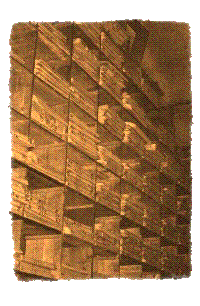
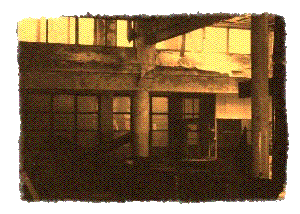
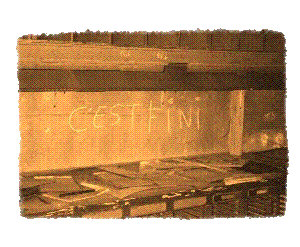
When our Dutch friends arrived, we were able to tell them of the good news. It was truly an extraordinary experience to walk in this place, forgotten by man and time for all those years. Nothing was missing, from the piles of yellow newpapers to the words «C’EST FINI» (it's over), chalked on a wall. We could almost feel the physical presence of Stanislas Sinclair and his team. We had to proceed with extreme caution, for the building, which shall remain nameless, was most decrepit. It would be sad if an over enthousiastic explorer was to hurt himself. Some interesting documents were found, but it may be a while before we can release them.
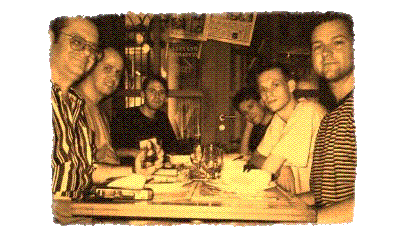
We came out with mixed feelings, a bit guilty to have entered this mystical place, but also dizzy to have trodded a small piece of the Other World. To put our emotions back together, we went to have lunch at the Horta restaurant, inside the CBBD. I will have to watch myself, I am starting to develop a taste for belgian beers…
Still drunk with our discovery of a Passage, we merrily went to another site, which Quentin had noticed a long time ago: the Albert Military Barracks. Some portions of this establishment, which is still active, have been left to decay. The part that we were interested in was the Dubeucq Block which, from the outside, is not especially remarkable. The facade is less drab than usual for a military building, but not to the point to make it a desirable attraction. It would be forgetting that this is Brussels, where the facades are not to be trusted.
The first clue that we were in a special place was the pile of numbered stones, stacked near the entrance and of a most familiar aspect. Behind the wide open door was a large room where sections of walls with peeling paint had the look of empty frames…
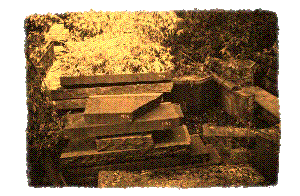
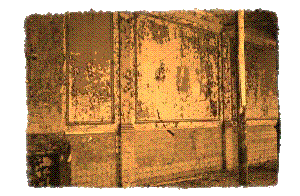
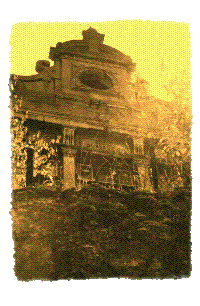
There was no longer any doubt: even with the colours, we recognized the inside of the A. Desombres Museum, as photographed by Marie-Françoise Plissart for L’Enfant Penchée! Only the frescoes were missing, but perhaps some fold in time had brought us just before the arrival of Augustin, and might not the artist show up any minute now?
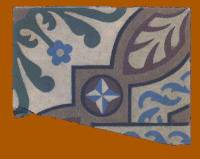
No, it could not be the same place. The splendid floor with the complex design was reduced to rubble, with not a single flagstone intact. Although, if memory serves me right, Desombres himself had started to tear down the floor to find the source of the mysterious vibrations that ran through the building (we did not feel them). We visited a few corners, tested some walls with a pendulum to see if there was not an active Passage, and left softly, not to wake up the ghosts.
Our next target was a big morsel: the famous Palais de Justice. On the way there, we made a little detour by the Chaussée de Namur to admire a little known mural, made by François Schuiten in his early years. Although not very Obscure, the style of the artist is nevertheless very recognizable and maybe one of these days we will see it in Samaris or some other City.
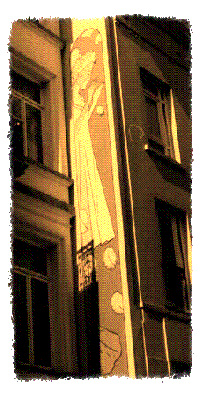
The Court House is indeed immense. To such a point that we get the reverse of the usual effect when we compare the real building with its rendering by Schuiten. While François tends to magnify scales, the Palais seems even larger than in the albums! So much stone! Such a mass must curve space within a considerable radius, and it is not surprising that this place is a point of Passage.
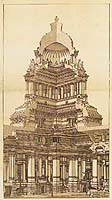
The scaffolds surrounding the dome are most intriguing. Is it an attemp to eliminate Obscure influences? Or, at the opposite, is somebody trying to top the building with a pyramid, the way Poelaert wanted it? The orientation is also striking. The main side faces the old proletarian neighbourhoods, down the slope. Apparently, the goal of the designer was to impress the lower classes with the grandeur of the official power. It is not surprising that the term «architek » has become an insult around here. Everybody uses the side entrance, which is more convenient.
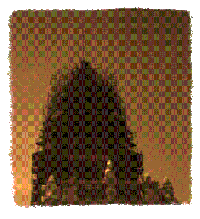
Even more than its dimensions, it is surprising to find out that much of this volume seems devoided of any practical function. Corridors and immense empty rooms apparently take a good deal of the available space. With few benches, not many statues or portraits, the Palais is a museum of emptiness. One would expect to meet Kafka behind a pillar…
In fact, there are not many people to be met at all. We did not see twenty persons in the whole building, most of them in the vast central waiting room. Not even the shadow of a guard! They say a plot to blow up the building was once discovered at the last minute, with explosives found in the basement. I beleive it with ease; they must have brought them by the barrelful, in broad daylight…
Nobody stopped us when we moved to the deepest cellars, where we found only freshly erected walls in places where Quentin is certain that there were tunnels only a few months ago. Obviously, «they» are trying to hide something.
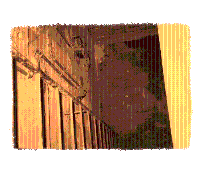
Finaly, after having visited some very interesting rooms, we discovered a well, deep and mysterious, with a ladder that reached into the darkness. It was impossible to go any further, for we had neglected to bring electrical lights. At most, we could hear a distant roar, like the muffled echo of a thousand vehicles running on high aerial roads… Next time, we will have to be better prepared…
A bit tired, and wanting to shop a little, our Dutch friends left us temporarely. Quentin, Mitya and I then continued to the Porte de Hal subway station. We also came quite close to the immense St-Pierre Hospital, which is reminiscent of the sprawling establishment designed by Doctor Dersenval in Brüsel.
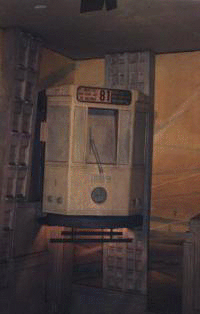
The station was known to us through numerous pictures, but it is always a different experience to see places like this in person. One of the tramways merged in the walls was the famous 81, but there is also a 55. Does it mean something? By a strange coincidence, there is a 55 bus line just in front of my house. So many mysteries, real or imagined!…


Today, we met another Obscure personnality: Florence Mainguet, the secretary of the Urbicande Non-Profit Organisation. The meeting is set at the Halles St-Géry. Another strike of good luck: I arrive a bit early, and there is an architectural exhibit inside. I learn a number of worthwhile tidbits on Brussels; this trip will have been most rewarding!
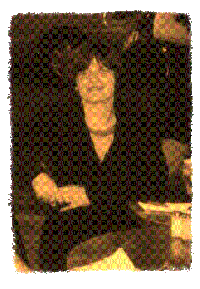
Florence comes in. She is charming, and most patient with the crackpots that we are. After a short search, we settle on the Pathé Palace for dinner. The talk is a little less easy than yesterday, for Florence does not speak English as well as Alok. I translate the more complex portions the best I can. Despite this slight handicap, we learn numerous details. Florence has an important role in the administration of the various Obscure exhibits, and she feeds us savoury tales about the practical problems one faces when trying to turn Schuiten's and Peters' paper dreams into reality.
Quentin had to leave briefly to greet our friend Olivier Tissot at the railway station. Théo, as we call him, is a Frenchman from Toulouse who lives in London. He is another contact from the Network that I met for the first time last week, and he sees all the rest of us for the first time too. It is regrettable that he was not able to free himself sooner, for he has missed several interesting events.
I took advantage of the occasion to renew my membership to Lumière sur les Cités, the club of the Urbicande Association. It may be the only time when I can pay cash.
Florence had gifts for us, too: magnificent Obscure posters! We ended the evening in a café with a superb and flamboyant period décor, where a cat was quietly sleeping on the best bench.
Saturday, July 31st, 1999
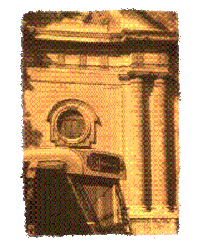
Another big day ahead, but the weather remains unshakably sunny and very warm. I should have brought more than one pair of short pants… We have set our rendez-vous point in front of the Sainte Trinité (Holy Trinity) church, not far from the Horta Museum. To get there, I took the 81 Tram. I now know why this line has such an importante place in Universe of the Cities. Not only is its path long and twisted, but it also goes by, or close to, several Obscure sites.
Quentin and Théo came in late, they visited the Urbicande Association offices this morning and have litteraly robbed Florence Mainguet.
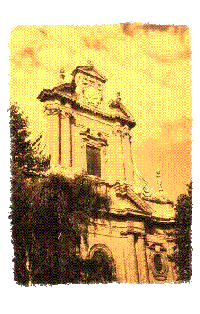
While waiting for them, we examined the front side of the nearby worship house. There is no doubt, it is indeed the monument that Freddy De Vrouw wanted to get rid of in Brüsel. A placard explains that this is the front of the Valentins church, built by Franquart in 1620 next to the Place de la Brouckère and demolished in 1895. Only this side has beeen saved, and carried stone by stone to the actual location. There are things that you can't possibly invent! We should have inquired ahead, the Horta Museum does not open before 2:00 PM. After having left a message to Mitya, who had not yet arrived, we managed, after much twisting, to squeeze all of us into Quentin's car.
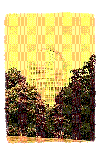
The Weirtz Museum was unfortunatly closed, but the Solvay Library was nearby, located in the middle of a park, not far from the Museum of Natural History and its famous iguanodons. Along the way, we saw the top of part of the European Parliament over a line of trees. It looks very much like a scene from Calvani! It appears that the library is only open for special occasions, but it is already quite satisfying to be able to trod around the A. Desombres Museum. Or is it the old von Rathen property in Mylos, later turned into the Koelber Foundation? No, the sky is much too clear today for us to be in Mylos.
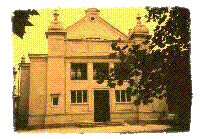
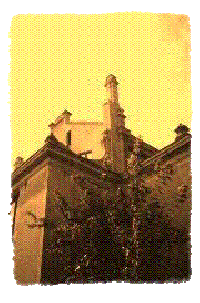
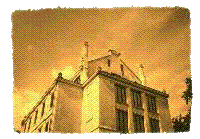
This building presents us with an interesting problem. What is it doing here? Has it been moved from Laguiolle? Haven't we seen some of its inner rooms yesterday, in the Albert Barracks? My mind builds up a twisted theory: what if there was some kind of elastic link between the von Rathen property and the A. Desombres Museum? Could the destruction of the latter have caused some feedback shock that would have scattered portions of a reflection of the original around Brussels, a city already half-way between the two worlds? I am so sorry that François and Benoît could not join us, there would have been so many questions to ask them!
Our Dutch friends go their own way again. Quentin, Théo and I want to visit the Cauchie House, and they have seen it already. Morever, they want to complete their own collections, and will go on a tour of several book shops located in the neighbourhood.
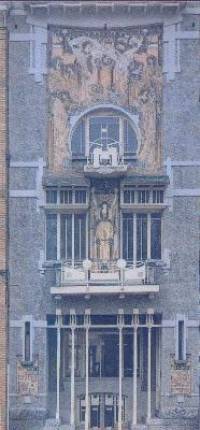
We are in luck, the Cauchie House is open to the public a single weekend each month, and it so happens that it is the right one. We learn, much to our surprise, that this is not a public monument, but a private house. The old workshop of the architect, installed in the basement, has been turned into a very interesting little museum and it is the owner that guides us through the house.
Obviously, the elderly couple to whom the building belongs is very much in love with it. Rightly so, for it is indeed a magnificient place. We are told, with much detail, how the house was virtually abandonned and came very close to be destroyed. The splendid murals of the dining room had been covered with wallpaper, and the sgrafittes of the front side were beginning to deteriorate.
With loving care, the new owners have patiently renovated, scrupulously following the original style. Most incredible is that the place was completely forgotten by the public until they started working on it. One wonders how many other such treasures are hidden under multiple coats of paint in this city.
Happy and hungry, we decided to have lunch on the terrace of a pleasant bistro, bordering a charming little public square. The architecture of the place was quite ordinary, but that did not stop me from enjoying a traditional dish of mussels in white wine, along with a plateful of pommes frites, which are justly famous.
Florence Mainguet had given us yesterday the address of two local obscurologists, and we wanted to meet them. Philippe Blampain and James Rooms are avid collectors, and they hope to one day open a Schuiten Museum. Apparently, the two friends have gathered more than three hundred posters and prints, over twelve thousand newspaper clippings and a few tons of various obscurities! It is rather mind-boggling! They both work in a lamp store, and splendid posters by François are used to demonstrate the power of the latest models, including superb luminares shaped like dirigibles. Is that a nod to the lamp shop on which Michel Ardan crashed in L'Ombre d'un Homme? Or am I the one who is beginning to see links everywhere?
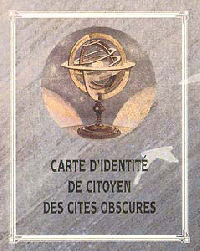
Philippe and James are, at any rate, especially knowledgable about the esoteric aspect of the links with the Obscure Cities. According to them, the library of Benoît Peeters contains many very curious books. Some of the details they mention are rather difficult to check, but I nevertheless take copious notes. One of their projects is most intriguing: to print Schuiten posters on authentic egyptian papyrus, left on top of the Great Pyramid at the exact moment of the equinox…
In a more earthly fashion, they have also produced the famous Obscure Identity cards, now used by the Lumière sur les Cités club, and several similar documents.
A few more book shops, and we go back to the Horta Museum. This this it's open, and our friend have already arrived. It is really worth a visit. It would even be better if it still had the original furniture but, like so many other treasures, they have been scattered all over. There are very ingenious details here, like those mirors in the stairwell and mobile doors to channel traffic in the entrance. Mitya, who is an architecture student, is absolutly beaming and takes numerous sketches.
We separate again. Quentin, Théo and I still have a few book stores to hit. There are truly fantastic collections in this town. Note to myself: I will need a larger suitcase on my next trip.
We join back the rest of the group at the Ultieme Hallucinatie, with a small detour by the Halles of Schaerbeek before reaching the restaurant. Another good supper, in good company. My last one here, unfortunately! It is with a heavy heart that I leave this place. My friends want to have a look at the Schaerbeek railway station, but I must return to the hotel and prepare my return trip. This night, I went to bed with a large smile and dreamed of strange builldings.
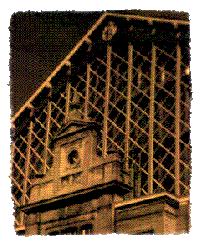
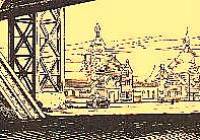
Sunday, August 1st, 1999
I am unable to go with my new friends to Mons, where they are to visit the Mundaneum. This dream of Paul Otlet, scenographied by Schuiten, is apparently very interesting. Sébastien Effinier, who translates into French the content of the «Web of the Obscure Cities» site, should however be there. I asked the others to please take pictures for me.
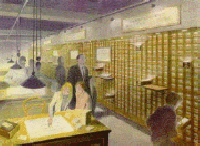
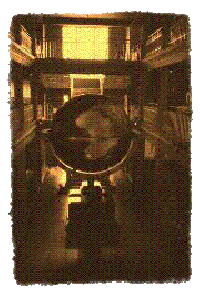
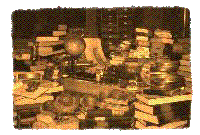
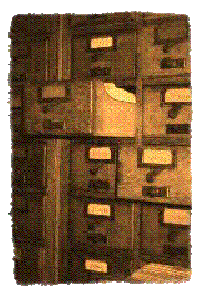
Everybody has been delighted by the meeting, and there is already talk of holding another one. With a bit of luck, Schuiten and Peeters will be able to participate this time, and the Maison Imaginaire will be open. I do not expect to return to Europe within the next four or five years so, sadly, I will probably not attend the next convention. Ah well, c'est la vie! I can at least take some consolation in the thought that I bring back from this trip enough material to be able to update the Obscure Dictionary for many months to come.
